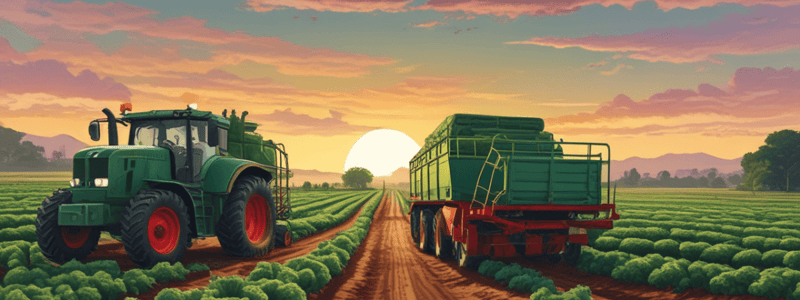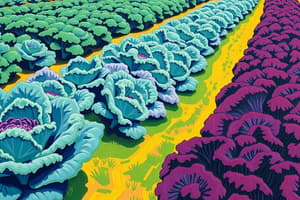Podcast
Questions and Answers
What is the primary purpose of growing a cash crop?
What is the primary purpose of growing a cash crop?
For profit and to be sold in the market.
What type of soil does kale prefer for growth?
What type of soil does kale prefer for growth?
Free-draining loam or sandy soil with a pH of 6-7.
How long does it take for kale to mature?
How long does it take for kale to mature?
5-6 months.
What is the recommended ratio of kale to silage/hay in an animal's diet?
What is the recommended ratio of kale to silage/hay in an animal's diet?
What is the main advantage of using kale as a fodder crop?
What is the main advantage of using kale as a fodder crop?
What is the primary method used to control the Flea Beetle pest in kale crops?
What is the primary method used to control the Flea Beetle pest in kale crops?
What is the primary purpose of growing an energy crop?
What is the primary purpose of growing an energy crop?
What is the benefit of using kale as a catch crop?
What is the benefit of using kale as a catch crop?
What is the main difference between zero grazing and strip grazing?
What is the main difference between zero grazing and strip grazing?
What is the name of the stored kale product?
What is the name of the stored kale product?
What is the soil-borne fungus that affects kale crops?
What is the soil-borne fungus that affects kale crops?
How does kale help the environment?
How does kale help the environment?
What is a major disadvantage of using kale as a fodder crop?
What is a major disadvantage of using kale as a fodder crop?
What is the benefit of kale in terms of animal feed costs?
What is the benefit of kale in terms of animal feed costs?
Study Notes
Types of Crops
- Cash crop: Grown for profit and sold in the market.
- Catch crop: Fast-growing crop grown between main crops, often used for animal feed.
- Energy crop: Grown for energy production, processed into fuels like bioethanol or biogas.
Kale Characteristics
- Prefers free-draining loam or sandy soil with a pH of 6-7.
- Sowing period: April to July.
- Growing time: Takes 5-6 months to mature.
Kale Usage
- Typically grazed as a fodder crop.
- Harvesting: Usually grazed in situ by cattle or sheep using a strip grazing system.
Grazing Methods
- Zero grazing: Crop cut by farmer and brought to housed animals.
- Strip grazing: Popular method; land must be suitable to avoid poaching.
Kale Diet
- Should be 70% Kale, supplemented with 30% silage/hay.
Kale Storage
- Ensiling: Stored as bales of 'kaleage'.
Advantages of Kale
- Reduces winter feed and housing costs.
- High in crude protein.
- Prevents soil erosion.
- Reduces nitrogen leaching.
- Increases soil organic matter.
- Enhances biodiversity.
Disadvantages of Kale
- Susceptible to pests and diseases.
- Risk of land poaching if grazed in situ.
Kale Pests and Diseases
- Club Root: Soil-borne fungus controlled by crop rotation and resistant varieties.
- Flea Beetle: Controlled by contact insecticide.
Types of Crops
- Cash crop: Grown for profit and sold in the market.
- Catch crop: Fast-growing crop grown between main crops, often used for animal feed.
- Energy crop: Grown for energy production, processed into fuels like bioethanol or biogas.
Kale Characteristics
- Prefers free-draining loam or sandy soil with a pH of 6-7.
- Sowing period: April to July.
- Growing time: Takes 5-6 months to mature.
Kale Usage
- Typically grazed as a fodder crop.
- Harvesting: Usually grazed in situ by cattle or sheep using a strip grazing system.
Grazing Methods
- Zero grazing: Crop cut by farmer and brought to housed animals.
- Strip grazing: Popular method; land must be suitable to avoid poaching.
Kale Diet
- Should be 70% Kale, supplemented with 30% silage/hay.
Kale Storage
- Ensiling: Stored as bales of 'kaleage'.
Advantages of Kale
- Reduces winter feed and housing costs.
- High in crude protein.
- Prevents soil erosion.
- Reduces nitrogen leaching.
- Increases soil organic matter.
- Enhances biodiversity.
Disadvantages of Kale
- Susceptible to pests and diseases.
- Risk of land poaching if grazed in situ.
Kale Pests and Diseases
- Club Root: Soil-borne fungus controlled by crop rotation and resistant varieties.
- Flea Beetle: Controlled by contact insecticide.
Studying That Suits You
Use AI to generate personalized quizzes and flashcards to suit your learning preferences.
Related Documents
Description
Explore different types of crops, including cash crops, catch crops, and energy crops. Learn about the soil suitability and growing requirements of kale, a popular crop used for animal feed and more.





